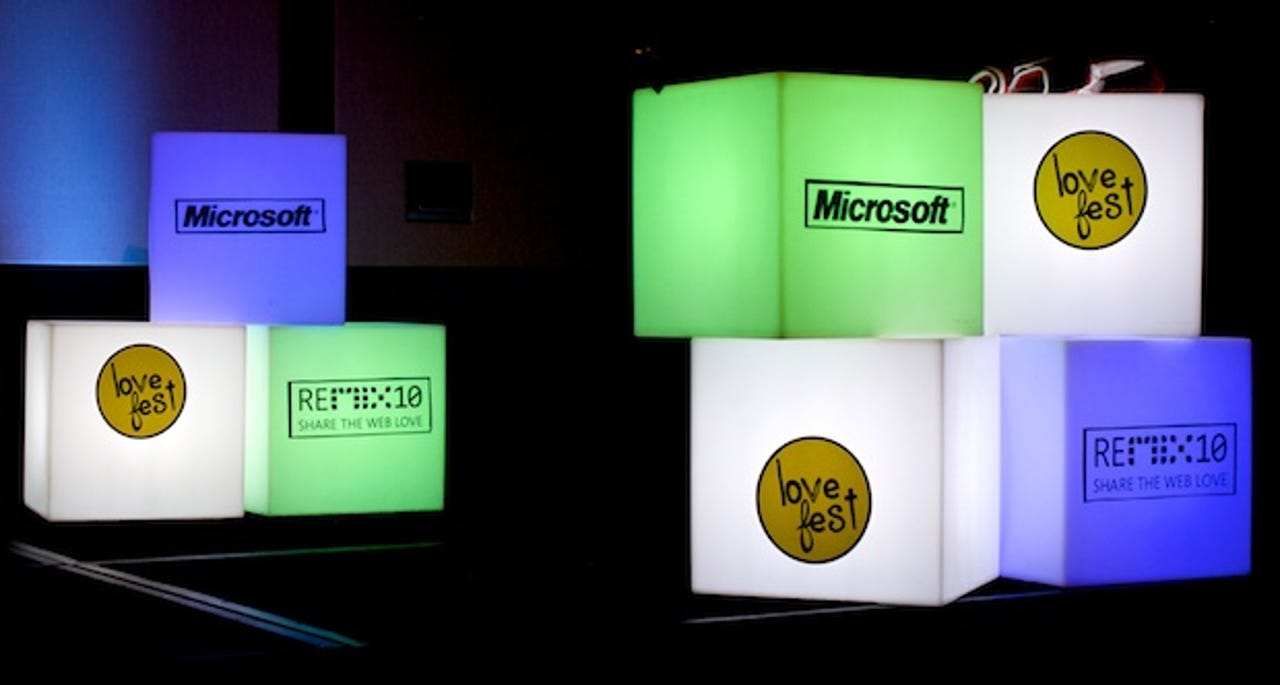Microsoft's ReMix10 lovefest: photos


"Lovefest" was the theme of the conference.
Apple may have been getting all the press lately, but ReMix10 was a sell-out, highlighting continuing interest in Microsoft's mobile development technologies.
Patrick Delany, Foxtel's executive director of content, product and delivery innovation, was the first to lay out his vision for the future. He painted a rosy picture of what lies ahead for the TV service. Foxtel's push to expand its pay-TV service outside the set-top box has found a strong ally in Microsoft, whose enabling technologies and Xbox 360 will soon bring Foxtel into Australian homes in new ways.
The table wasn't just a prop when developer evangelist Michael Kordahi (right) and user experience evangelist Shane Morris sat down for a cuppa; the table, a touch-sensitive Microsoft Surface computer (shot by the cameraman), is running an app with links into Foxtel services.
Kordahi said the various Microsoft development tools have come together to provide seamless movement of data between devices.
Kordahi put his phone onto the Surface, which recognised the Foxtel application on the device. Working through the table, the Foxtel application pulls up options to record and view Foxtel content on the phone. Intelligent agents display recommendations of possible movies on the Surface's screen, and that content can be dragged straight onto the phone using a fingertip.
Kordahi and Morris put on boxing gloves to record Kordahi's knockout blow; here, Morris is on his way to meet the canvas.
The action was recorded and immediately available as an Instant Replay on Kordahi's Windows Mobile phone. This sort of application could be deployed at a sporting event, with a press of the mobile screen providing an instant replay straight from Foxtel's feed of the event — while the spectators are still at the event.
Foxtel's intelligent-agent software has automatically added the instant-replay shot to a video library, which can be accessed later via tablet PC. "What we've architected is a journey," Kordahi explains. "We've integrated the Foxtel brand throughout the entire journey. That's the fundamental thing that the technology today does: it allows you to do things across devices, not just render things on a screen."
Tatham Oddie from Microsoft partner Readify provided a walkthrough of Internet Explorer 9's major features.
This shot shows a 3D animation running inside an Internet Explorer 9 web page.
Microsoft's Graham Elliott highlighted new interactive tools that allow for quick sorting and resorting of a large data set — in this case, perusing a large wine retailer's inventory. In the background, Elliott has zoomed in close to see details of a particular bottle he likes. Web-based availability of massive data sets, currently encapsulated in a project codenamed "Dallas", is expected to revolutionise the depth and breadth of online services.
Windows Mobile 7 had a strong presence at ReMix10 even though it won't actually be shipping on real phones until the end of the year.
Attendees had to content themselves playing with the new operating system through an emulator on a touchscreen PC.
The conceptual idea behind Windows Phone 7, with destinations arranged to allow side-scrolling between different parts of the application.
Developer and author John Allsopp enthusiastically ran through the key elements that are rapidly turning the web into a replacement for the operating system, in the same way that the emphasis on operating systems shifted the focus away from speeds and feeds. "No one really cares what's in the box any more," he said. "On the whole, computing hardware has vanished. In the next couple of years, the OS is going to vanish in the same way the hardware has. We're not going to care about the OS any more; the web is going to play that role."
He highlighted some of the advancements in HTML5, including 3D rendering of elements.
HTML5's built-in support for SVG (scalable vector graphics) will facilitate rich, scalable animations.
No Microsoft conference would be complete without Xboxes for everybody.
You know you're at a development conference when this is considered an easy way to enter a prize draw. Whatever happened to dropping your business card in the box?
This motorised Esky, one of several prizes available to attendees, might be most at home filled with Red Bull and cruising the floor of a software house filled with furiously-coding developers.
Each participant was given a Rubik's cube, with all cubes assembled to reveal an Internet Explorer logo.
There was considerable interest in another Surface computer: attendees could scan their details and automatically request information from conference sponsors be sent to them, just by dragging the sponsor's details onto their green information bar.
Readify's Stephen Nagy tackled the architecture of cloud computing from a developer's perspective.